Abstract
This study is devoted to the development of an algorithm for creating a temporary (2–5 years) project group to solve problems dictated by the innovative vector of business development. The authors have noted that knowledge workers are the main factor of any design and innovation activity. It has been shown that methods for assessing the competence of knowledge workers should differ materially from those used to evaluate “manual“ workers or clerks. Search, selection, and management of professional skills and professionals in the field of professional development, as well as retaining the most useful and experienced knowledge workers with a company are the key activities of a Human Resources Department. The authors have substantiated the need to automate the assessment and selection of knowledge workers as a basis for the implementation of innovative projects. The developed algorithm takes into account the different qualifications of specialists engaged in a particular project, as well as the forced employees’ dead time at certain stages of job performance. To illustrate the algorithm operation, we have given a numerical example of creating a team. Based on the suggested algorithm, we have highlighted the prospect of creating a software which automates all stages of creating a team including knowledge workers. The use of such software simplifies the procedure for creating teams to implement innovative project and increases the knowledge workers’ productivity.
Keywords: Human resource managementknowledge workerscompetencecombinatorial analysisinnovative project
Introduction
The human capital is a key and a system-forming factor of any business system’s activity and viability. All productive resources of an enterprise are implementation of the personnel’s experience and knowledge in material or intellectual form. Search, selection, recruiting, adaptation, and training of personnel; management of their professional development and working efficiency, as well as retaining the most useful and experienced professionals are the key activities of a HR department (Shahbazov, 2016).
One of effective ways to do modern business is carrying out design and innovation activities. Successful implementation of this activity requires planning, evaluation, management, retention, and training of knowledge workers (Martin, 2013). This category of workers is characterized by their research and creative competences, the apparatus for assessment of which has not been sufficiently developed to date (Soo, Tian, Teo, & Cordery, 2017). There are some studies (Lysenko & Kovaleva, 2016; Lysenko & Sereda, 2018) devoted to the management of talented workers. Talented workers undoubtedly belong to the category of knowledge workers. In a project, they usually act as ideological generators. They can be referred to as top managers. Each worker of the “talent” category is unique, but this sub-group of knowledge workers is small enough. Today, effective implementation of innovative projects requires managers and experts of the middle management level, who are able to work simultaneously on several projects.
HR planning, including knowledge workers, can be divided into three types: planning of HR requirements, planning of staff recruiting (hiring), and planning of staff costs. Such important types of planning as the planning of staff training, staff retention, the planning of HR use, and the planning of layoffs. Traditionally, the the notion of “competence” includes the field of knowledge, skills, and practical experience of a worker, that are required to solve specific tasks with an enterprise. This notion also includes the scope of the employee’s responsibility for solving issues related to business tasks. In fact, competence implies the suitability of an employee to perform specific business tasks. The task of assessing the competence of knowledge workers or, as stated in (Soo, Tian, Teo, & Cordery, 2017), the task of managing knowledge workers is rather difficult. The knowledge workers’ competence assessment cannot be carried out by testing. The knowledge workers’ competence can be reliably assessed in the interview with an employee who has a greater competence in the relevant field. Therefore, knowledge workers should not be treated as “manual” or “paper” workers, performing everyday routine jobs within their competences.
There are works that suggest evaluating the competence of specialists (including knowledge workers) on the basis of an expert evaluation based on objective data, for example, identifying trends in the development of innovative technologies and determining their respective competencies based on the analysis of trends in patent activity (Nikulchev, 2017), or based on the data of professional social networks, analyzing which you can assess the communication competence in the professional field (Plokhov, 2016).
Problem Statement
The traditional measure of the effectiveness of the project is the costs, time, schedule and scope of work. An innovative project is usually an interdisciplinary one; it can last for several years with or without breaks; therefore, its successful implementation requires enough knowledge workers who, probably, will not be engaged in the project implementation for a time all their working hours, and they will not necessarily have the required set of competences. Hence, the practice of productive and seamless transfer of employees within an enterprise, who have experience and knowledge, to create temporary (for a period of 2–5 years) teams for addressing specific project or innovation tasks, is becoming more relevant.
In the modern human resources management systems (HRM-system), all processes of operational management of human resources (hiring, dismissal, timesheets, personnel transfers, etc.) are fully automated. The functions of planning, selection, and training are available only in multifunctional expert systems that are developed immediately (directly) for large business systems, taking into account the subject area of their business. For example, Oracle Human Resources Analyzer (Stephan & Gretczko 2017) plans the career development of business system’s employees. The module SAP Human Resources Management System (SAP, 2018) automates the planning of staff costs, their working hours, and their use. The use of an integrated system IEX TotalView (FutureSoft, 2018) allows for creating staff’s timesheets, tracking the job distribution effectiveness, determining the requirements for the level of employees’ professional knowledge level and skills, but also for a contact center. Note that these solutions deal with the competence of employees engaged in routine operational activities.
Research Questions
This paper discusses the following issues:
developing a sufficiently general algorithm for the formation of a team to implement an innovative project, which will take into account the competence of knowledge workers;
showing the reduction in the timing of an innovative project, based on a concrete numerical example.
Purpose of the Study
The goal of this paper is developing a sufficiently general algorithm for the formation of a team to implement an innovative project with regard for the competence of knowledge workers and proving the efficiency of the algorithm for a concrete numeric example.
Research Methods
The algorithm is developed on the basis of combinatorial analysis methods.
Findings
Assuming that implementation of design and innovation activities requires performing several individual jobs , let us designate them as a set of (1), where N is the total number of predefined separate jobs or stages thereof.
Mathematical statement of the problem
First, we will compile a correspondence table, i.e. we will define the employees who are able to perform at least one of the jobs
from the total set of planned jobs. In the explanatory correspondence table in Fig.
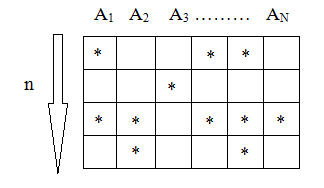
The table in Fig.
Our goal is minimizing the timing of performing jobs .
Further, we introduce time values (2), where is the time required to perform the ith job by one employee. The time spent by employee i for job j shall be described as .Thus, the total worktime of the ith employee shall be (3), where is the time of the possible dead time of the ith employee (the index “d” comes from English “dead time” or “delay”). We assume that the employee’s dead time can be included in the main time of his or her activity.
Given that, according to the condition above, one employee cannot perform two or several jobs simultaneously, (3a) (here П is the sign of intersection).
Let us denote as the largest total worktime of the ith employee. The following problem arises: we have to find a distribution of employees by all jobs for the planned time J to be minimum, i.e. we shall introduce an optimization criterion:
Solving the Problem
Let us start from the question whether there is at least one variant where all planned jobs under the project can be performed by the available staff? Only in this case, we can consider the problem of minimization (4). Let us show that there is a solution that is far from the optimal one. For this purpose, it is sufficient to agree upon a stage-by-stage implementation of all jobs. At first, the stage of job А1 is implemented by one employee (while the others are waiting). Then, job А2 is implemented by the same or another employee (according to table in Fig.
Therefore, there is a trivial solution of the problem. Let us remind that Тi is the time of implementing the ith job by one employee. Here, we should also note that finding a well-formalized procedure for solving the optimization problem is rather difficult. With a high dimension of the problem, the exhaustive search method is hardly acceptable in our case. In addition, do not forget that we are dealing with a discrete problem: an employee who started a specific job, necessarily ends it. Let us show that, based on heuristic considerations, the above trivial solution (5) can be significantly improved.
The basis for further consideration is the following “stage-by-stage” approach: at each stage k, we try to use the minimum number of workers, as well as the time that was not used at the previous stages.
Assume that job А1 can be performed by m
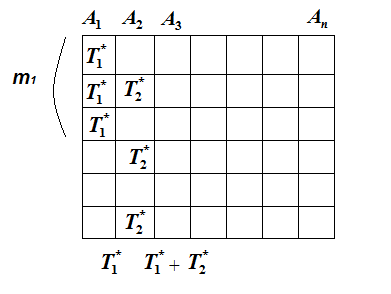
We pre-rank the timing of jobs in the table in Fig.
In our example, the second job will be started at the moment Т1*. Therefore, jobs А1 and А2 will be performed for a time Т1* + Т2*, after which the third job will be started, etc.
Let us mention an important point for further consideration. As can be seen in our hypothetical case, there are employees in the team, who are free from job А1, being able to perform job А2 (the two lower employees in the second column). Therefore, these two employees can perform their part of job А2 in advance, as shown by arrows in Fig.
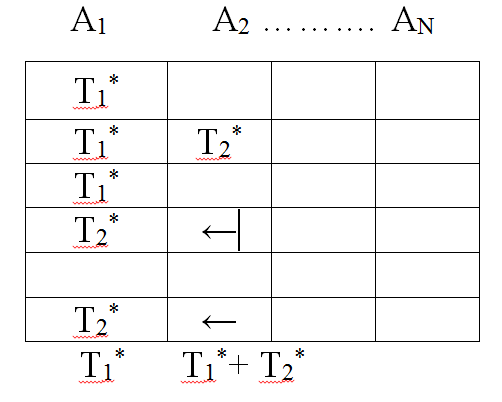
Further, the procedure continues in the same way for jobs А3 …AN. As a result, we find the time of performing all jobs А1 to AN. For more clarity of this procedure, we will consider below a simple example of solving the problem for the selected optimization criterion.
Note: Given that, in our case, specialists can have different qualification, the time of performing job Ai by employee “k” shall be equal to Tik, where k = 1…..n. For example, let us assume that job А1 can be performed by “m1” employees having different qualifications. Then, time Т1** of performing this job, instead of Т1/m1, as previously assumed with an equal qualification of employees, shall be equal to:
In this case, we shall add the values of time Тi**, calculated according to (7), to the relevant cells of the tables in Figs. 2 and 3.
Numerical example
Let assume that five jobs A1 … A5 (N=5) shall be performed by four employees (n =4). In this case, according to (6), we assume that Т1 = 5 months (m), Т2 = 4 m, Т3 = 3 m, Т4 = 2 m, and Т5 = 1 m. Presume that specific workers (marked by asterisks), who implement an innovative project, are ranked in the table in Fig.
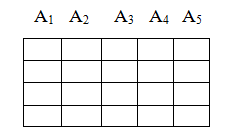
From the table in Fig.
m1 = 3, m2 = 3, m3 = 3, m4 = 2, and m5 = 3. From the table in Fig.
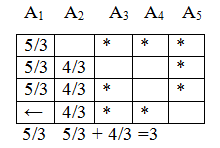
As we can see, the fourth specialist in job А2 can perform his or her job А2 for a time Т1*, as he or she is not engaged in job А1. Thus, jobs А1 and А2 have been performed for a time Т1* + Т1* = 3 months.
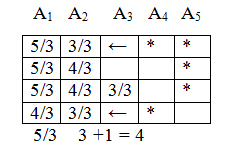
From the table in Fig.
Continuing in the same way, we get the correspondence table in its final form.
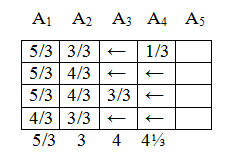
As follows from the table in Fig.
Conclusion
Based on a combinatorial analysis, the suggested general algorithm to create a team for an innovative project, including knowledge workers, makes it possible to significantly reduce the implementation timing of innovative projects, based on a minimization criterion as defined in this study. The suggested algorithm takes into account different qualifications of employees engaged in a particular project, as well as the forced dead time of employees at various stage of job performance. The further development of this study presumes creating a software implementation based on this algorithm, which could simplify the procedure for creating teams of knowledge workers, as well as to increase their productivity in design and innovation activities in the research, engineering, and education fields.
References
- FutureSoft (2018). Work force management solutions [PowerPoint slides]. Retrieved from http://www.futuresoftindia.com
- Lysenko E., & Kovaleva I. (2016). Involvement of Personnel in the System of Talent Management: Content-analysis of International, Federal and Regional Companies’ Sites, Having Activities on the Territory of Russian Federation. In The 3rd International Multidisciplinary Scientific Conference in Social Sciences and Arts. Conference Proceedings. Book 1. Psychology & Psychiatry, Sociology & Healthcare, Education. Vol. III. (pp. 549-556)
- Lysenko, E., & Sereda, E. (2018). The new job position in human resources management: the talent manager. In The European Proceedings of Social & Behavioural Sciences, 37, 51-58. doi 10.15405/epsbs.2018.03.02.5
- Martin, L., & Lafley, A. (2013). Rethinking the decision factory. Harvard Business Review, 91(10), 96-105.
- Nikulchev, E., Ilin, D., Bubnov, G., & Mateshuk E. (2017). Scalable service for predictive learning based on the professional social networking sites. International journal of advanced computer science and applications, 8(5), 9-15. doi 10.14569/IJACSA.2017.080502
- Plokhov, D., Osipov, I., Titov, S. & Nikulchev, E. (2016). Study the efficiency of interproject communication with social network analysis. Quality - access to success, 17(153), 103-107
- SAP (2018). Get measurable results with our talent management suite. Retrieved from https://www.sap.com/products/human-resources-hcm.html
- Shahbazov, A. (2016). Talent management. Retrieved from http://originaltm.com/upravlenie-talantami-zapadnaya-blazh/.
- Soo, C., Tian, A., Teo, S.T.T., & Cordery, J. (2017) Intellectual capital–enhancing HR, absorptive capacity, and innovation. Human resource management, 56(3), 111-132. doi. 10.1002/hrm.21783
- Stephan, M, & Gretczko M. (2017). Digital HR: A Revolutionary Leap Forward. Human resources, Oracle. Retrieved from https://blogs.oracle.com/oraclehcm/digital-hr-a-revolutionary-leap-forward
Copyright information

This work is licensed under a Creative Commons Attribution-NonCommercial-NoDerivatives 4.0 International License.
About this article
Publication Date
23 November 2018
Article Doi
eBook ISBN
978-1-80296-048-8
Publisher
Future Academy
Volume
49
Print ISBN (optional)
-
Edition Number
1st Edition
Pages
1-840
Subjects
Educational psychology, child psychology, developmental psychology, cognitive psychology
Cite this article as:
Andrianova, E., Bulanova, Y., Golovin, S., & Tomashevskaya, V. (2018). Building An Innovative Project Team Using Combinatorial Analysis. In S. Malykh, & E. Nikulchev (Eds.), Psychology and Education - ICPE 2018, vol 49. European Proceedings of Social and Behavioural Sciences (pp. 46-53). Future Academy. https://doi.org/10.15405/epsbs.2018.11.02.6

